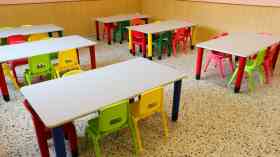
Creating fire-safe educational settings
Fire risk for schools is reported to be almost double that of other non-residential buildings. Yet sprinkler systems are still not mandatory for all schools in England. Jonathan Dyson from the National Fire Chiefs Council, explains why this is a problem
We at the National Fire Chiefs Council have long been advocating for mandatory sprinklers in all new and substantially refurbished schools in England. Effective sprinkler systems are vital, along with other fire safety measures, such as fire alarms and fire doors, for protecting schools against the risks of fire. Indeed, sprinklers are the single most effective method for fighting the spread of fires in their early stages.
It is NFCC’s position that it should be mandatory for sprinkler systems to be fitted in all new schools, and that sprinklers should also be retrofitted in existing school buildings when relevant refurbishment takes place. Voices from across the sector have been united in calling for these changes, including the Fire Brigades Union, the National Education Union, the National Association of Head Teachers, the Fire Protection Association, the European Sprinkler Network, the Business Sprinkler Alliance, Zurich, and the Association of British Insurers.
School fires in England in recent years have demonstrated the importance of having mandatory sprinkler systems. In May 2020, there was an accidental fire in Harrington Junior School in Long Eaton, Derbyshire, which did not have sprinklers installed. The fire was caused during refurbishment works. Fortunately, everyone was able to get out safely and there were no children in school at the time. However, two firefighters incurred slight injuries and the entire building was destroyed in the blaze. This was despite the efforts of fire and rescue service crews from across Derbyshire, Nottinghamshire, and Leicestershire working throughout the night to to damp the fire down and extinguish hot spots.
A temporary school had to be built to house the pupils, who suffered disruption from working at home and being moved to temporary accommodation. Sprinklers would have contained or extinguished the fire with minimal disruption to children’s education and the wider community. The school was rebuilt across England in 2021-22, Home Office figures have shown that 219 primary and secondary schools were damaged by fire.
Fires on the same site at an estimated cost of £5.5 million and with a formal commitment to installing sprinklers. The cost of installing sprinklers in the original school building would have been significantly less, at an estimated cost of between £65K–£84K.
One evening in October 2018, an electrical fault in a washing machine caused a fire at Outwood Academy Bydales in Marske, North Yorkshire. The school had sprinklers installed. Although two fire engines responded, on their arrival the sprinkler system had activated and had already extinguished the fire. The school was open as usual the next day, and the result was minimal fire damage and minimal impact on students, staff, and the community.
Buildings more at risk
Research by Zurich found that the average fire risk for schools is almost double that of other non-residential buildings. Across England in 2021-22, Home Office figures have shown that 219 primary and secondary schools were damaged by fire. This is a 35 per cent increase on the previous year. The Department for Education held its consultation ‘Building Bulletin 100: Fire Safety
We have previously highlighted the current‘post code lottery’ in sprinkler requirements and have advocated for a streamlined position across the whole of the Uk. New schools should have fire sprinklers installed except in a few low risk schools”. It’s worth highlighting that it is estimated that currently only 15 per cent of new schools in England are being built with sprinklers, yet in 2007, 70 per cent of new schools has sprinklers installed. NFCC believe that these proposals represent a retrograde step and that we should instead be improving fire protection in our schools, so we urge the government to bring forward more robust guidance.
An important element of this will be ensuring that school building designers and developers cannot sidestep BB100 and improvements such as sprinklers and evacuation lifts. This will require the government to mandate the use of design guidance in all new school buildings, preventing designers and developers from circumventing BB100. This would close the loophole by which they can instead use Statutory Guidance Fire safety: Approved Document B or BS 9999: Code of practice for fire safety in the design, management and use of buildings, as these do not take account of the impact of school fires on students’ education, the wider community, or public asset protection.
A post-code lottery
We have previously highlighted the current ‘post code lottery’ in sprinkler requirements and have advocated for a streamlined position across the whole of the UK. Unlike the current situation in England, both Scotland and Wales have made sprinkler installation mandatory in all schools, regardless of height. NFCC believe that this is an opportunity for the government to close the current loopholes, make sprinklers mandatory in all new and substantially refurbished schools, and provide schools in England with an equal level of fire protection as in other parts of the UK.
Jonathan Dyson is Automatic Water Suppression Systems Lead at the National Fire Chiefs Council (NFCC)
Latest News
19/12/2025 - 09:54
The Education Committee has expanded its ongoing inquiry into the early years sector to examine how safeguarding can be strengthened in early years settings.
18/12/2025 - 09:25
The UK will be rejoining the Erasmus programme in 2027, following a package of agreements with the EU.
17/12/2025 - 09:31
Ofqual has fined exam board Pearson more than £2 million in total for serious breaches in three separate cases between 2019 and 2023 which collectively affected tens of thousands of students.
16/12/2025 - 09:19
The average funding rates will increase by 4.3% for under 2s, and by almost 5% for 3-and-4-year-olds.
15/12/2025 - 10:30
Local colleges are set to receive £570 million in government funding to expand training facilities in areas such as construction and engineering.







